Vienna sausages are a long-lasting snack, boasting an impressive shelf life of 2 to 5 years when unopened. Store them in a cool, dry place, and they'll remain safe and tasty well past the Best By date. After opening, consume your sausages within 3 to 4 days, or freeze them for 1 to 2 months in airtight containers. Regularly check for signs of spoilage, like off smells or unusual textures, to guarantee safety. These versatile treats can spice up many dishes, and there's plenty more to discover about their storage and culinary uses.
Key Takeaways
- Unopened canned Vienna sausages can last 2 to 5 years beyond the Best By date when stored properly.
- Opened cans should be refrigerated and consumed within 3 to 4 days for optimal freshness.
- Leftover opened sausages can be frozen in airtight containers for 1 to 2 months to extend shelf life.
- Proper storage conditions, such as cool and dry environments, significantly enhance quality and longevity.
- Regularly inspect cans for signs of damage, such as bulging or rust, to ensure safety before consumption.
Overview of Vienna Sausages
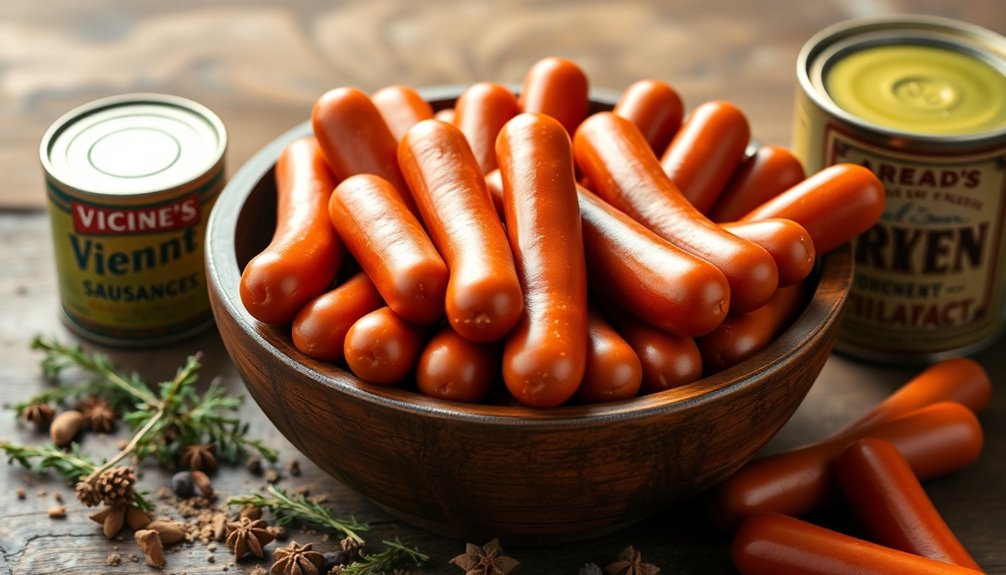
Vienna sausages are a convenient snack that packs a flavorful punch. Originating from Vienna, Austria, these short, slender sausages boast a rich history rooted in a tradition of expert sausage-making. Made primarily from a blend of pork and beef, Vienna sausages are pre-cooked, salt-cured, and often smoked, enhancing their taste and making them perfect for quick consumption.
You'll find that canned Vienna sausages generally offer an easy way to enjoy this protein-rich option. With around 229 calories per 100g and an average of 6 grams of protein per serving, they're not just tasty but also filling. However, keep in mind their high sodium content.
Versatile and easy to use, Vienna sausages can be served with crackers, cheese, and mustard or added to a variety of dishes like pasta, pizza, soups, and casseroles. You can even grill, fry, or microwave them for a warm, savory treat.
Whether you're hosting a cocktail party or need a quick snack, Vienna sausages bring flavor and convenience to your table, making them a go-to choice for many.
Shelf Life and Storage
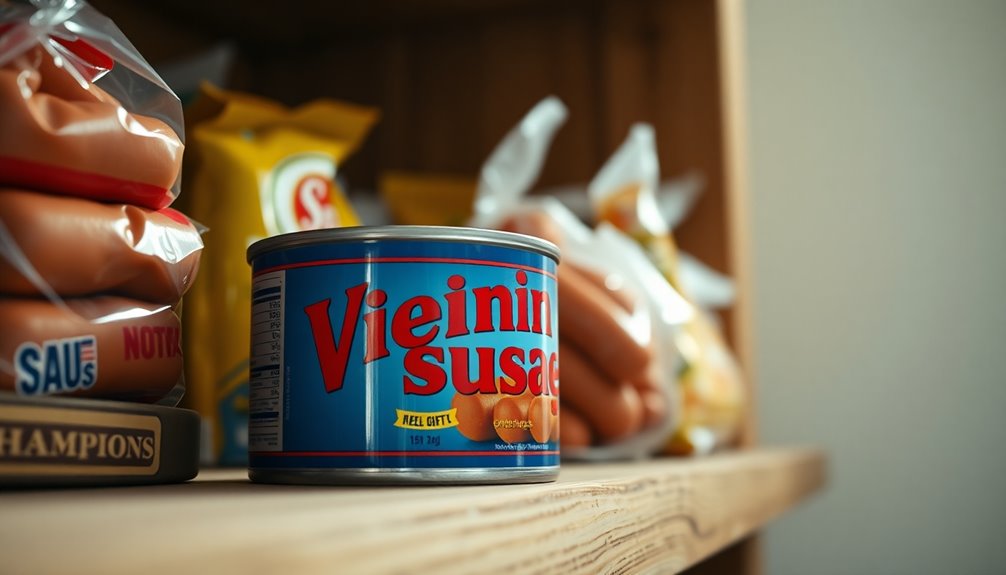
When it comes to storing Vienna sausages, you'll want to keep an eye on their shelf life to enjoy them at their best. An unopened can can last between 2 to 5 years beyond the printed Best By date if you store it in a cool, dry place away from sunlight. Proper storage is essential to maintain their quality.
Once you open a can, refrigerate the sausages immediately and aim to consume them within 3 to 4 days for ideal safety and taste.
If you find yourself with leftover opened sausages, consider freezing them in airtight containers. This method can extend their shelf life up to 1 to 2 months without compromising quality.
It's also wise to regularly inspect your cans for any signs of damage, like bulging or rust, as these can indicate spoilage and pose health risks.
Factors Influencing Shelf Life
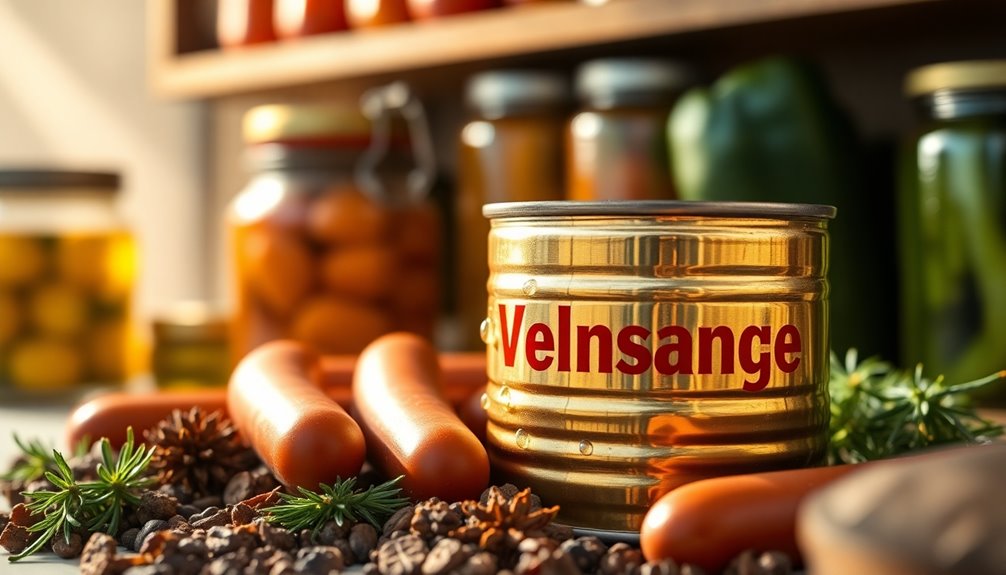
Several factors can greatly influence the shelf life of Vienna sausages, guaranteeing they stay safe and tasty for as long as possible. The canned process used for these sausages is a major contributor to their longevity, as it inhibits bacterial growth. Proper storage conditions are essential, too. Keeping unopened cans in a cool, dry environment can enhance preservation and prolong shelf life.
Here's a quick overview of key factors affecting shelf life:
| Factor | Influence on Shelf Life |
|---|---|
| Canned Process | Inhibits bacterial growth |
| Storage Conditions | Cool, dry environments enhance preservation |
| Exposure to Heat | Can shorten shelf life |
| Humidity | Adversely affects quality and longevity |
| Preservatives | Help maintain flavor and quality over time |
Additionally, be mindful of any signs of damage, like rust or bulging cans, which can compromise safety. By understanding these factors, you can guarantee your Vienna sausages remain a delicious and reliable snack option for a long time.
Signs of Spoilage
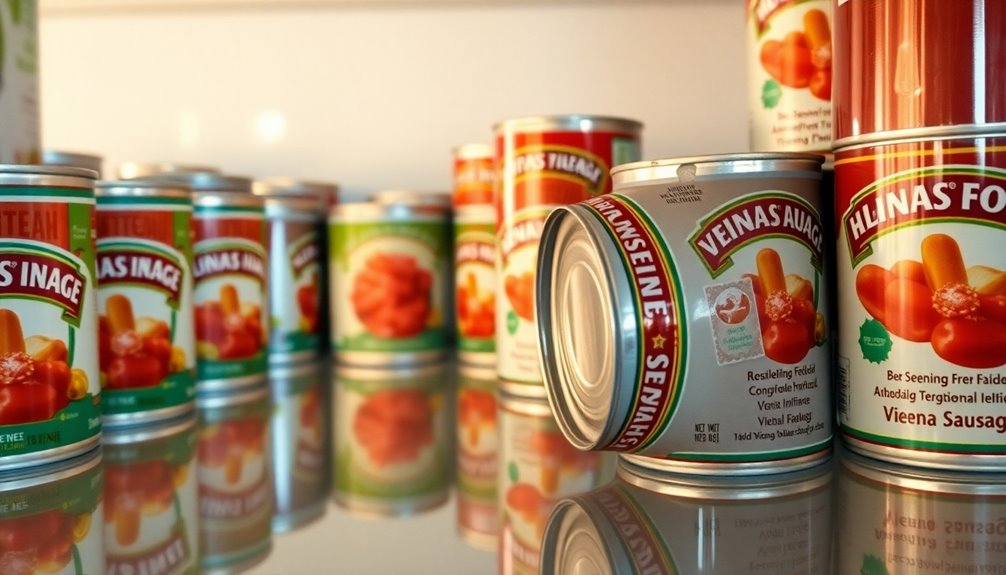
Recognizing signs of spoilage in Vienna sausages is essential for ensuring your safety. First, always check the expiration date printed on the can. If it's past this date, discard the sausages, as they may not be safe to eat.
One of the most obvious signs of spoilage is an off smell; if the sausages have a strange or unpleasant odor, don't take any chances—throw them out.
Next, inspect the sausages for discoloration. If you notice a gray or unusual hue, this indicates that they've deteriorated and aren't fit for consumption. Additionally, feel the surface of the sausages; a slimy or sticky texture is a clear indicator of spoilage.
Also, examine the can itself. If you see any bulging, rust, or dents, it could mean the product is compromised and unsafe to eat.
Trust your instincts—if something doesn't seem right, it's best to err on the side of caution. Always prioritize your health and safety when enjoying Vienna sausages!
Preservation Methods

When it comes to preserving Vienna sausages, you've got several effective methods at your disposal.
Salting and brining can keep bacteria at bay, while cold smoking enhances both flavor and longevity.
Traditional curing processes also play a key role in maintaining quality, ensuring your sausages stay fresh longer.
Salting and Brining Techniques
Salting and brining are effective techniques for preserving Vienna sausages, enhancing their shelf life while keeping them safe to eat. When you use salting, you're coating the sausages in salt, which draws out moisture and inhibits bacterial growth. This method can extend the shelf life of your sausages without requiring refrigeration, making them a convenient snack option.
On the other hand, brining involves soaking the sausages in a saltwater solution. This not only preserves the meat but also infuses it with moisture, enhancing flavor and texture. For best results, make sure the sausages are completely submerged in the brine. This will protect all parts of the meat from spoilage while maximizing flavor absorption.
While salting and brining notably increase the shelf life of Vienna sausages, it's important to monitor the sodium content in the brine. Too much salt can lead to health concerns, so balance is key. Additionally, be aware that high sodium levels can pose risks for certain pets, particularly dogs, who may be sensitive to toxic foods like raisins.
Cold Smoking Methods
If you're looking for another effective preservation method for Vienna sausages, cold smoking is a fantastic option. This technique involves exposing the sausages to smoke at temperatures below 90°F (32°C), enhancing their flavor while preserving the meat without cooking it.
By reducing moisture content, cold smoking methods effectively inhibit bacterial growth, allowing for extended storage. With the right approach, your cold-smoked sausages can be safely stored for several weeks or even months without refrigeration.
The smoking process creates an environment that's unfavorable for spoilage, making it a reliable preservation choice. Additionally, the smoke contains natural preservatives like phenols and aldehydes, which contribute to the antimicrobial properties of the sausages, further ensuring their longevity.
To achieve traditional cold smoking, you can use various wood types, such as hickory, apple, and cherry. Each wood imparts unique flavors to your sausages, making the process not only practical but also enjoyable.
Traditional Curing Processes
Traditional curing processes are essential for preserving Vienna sausages, ensuring they remain safe and flavorful for extended periods. These methods primarily involve using high sodium levels and nitrites, which effectively inhibit bacterial growth and extend the shelf life of Vienna sausages.
The process begins with salting the meat, which draws out moisture and creates an environment that's less hospitable to spoilage. This moisture reduction is vital for maintaining quality over time.
After salting, you might notice that the sausages undergo air-drying, further enhancing preservation without needing refrigeration.
Cold-smoking is another effective technique, adding depth of flavor while simultaneously removing moisture, resulting in a shelf-stable product.
These traditional curing processes have been relied upon for centuries, allowing sausages to remain safe for consumption without refrigeration, depending on the specific techniques and conditions used.
Nutritional Information
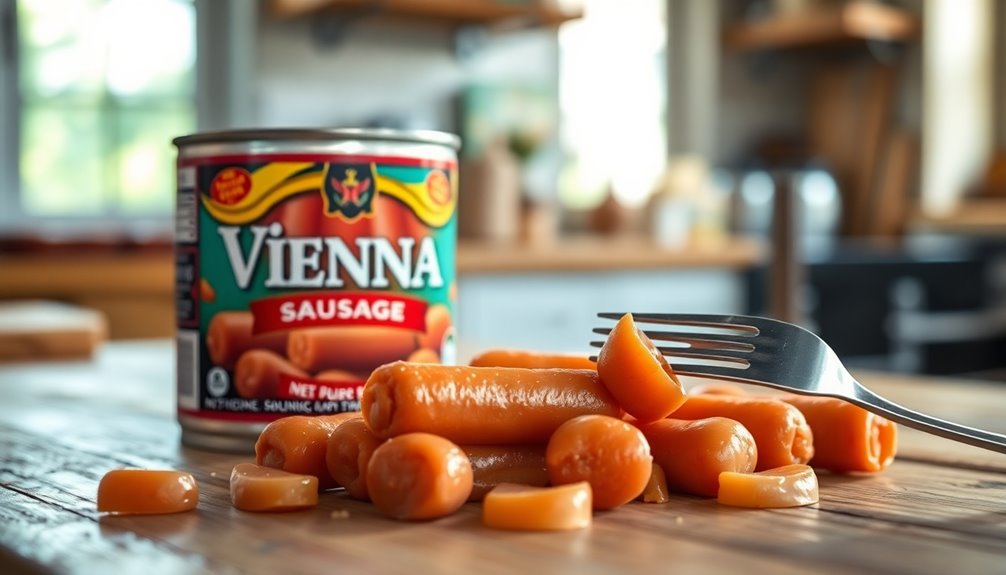
Vienna sausages are a popular snack choice, but it's vital to grasp their nutritional profile. Each serving typically contains about 110-140 calories, making them a high-calorie option for your snacking needs. If you're looking for a protein boost, you'll get approximately 5-7 grams of protein per serving, which can contribute positively to your daily intake.
However, it's crucial to evaluate the fat content as well, which ranges from 9-11 grams per serving. For those monitoring fat intake, this could be a point of concern.
Additionally, Vienna sausages are known for their high sodium levels, averaging around 400-600 mg per serving. If you're on a low-sodium diet, you'll want to enjoy these in moderation.
Another aspect to keep in mind is that Vienna sausages often contain preservatives. These additives extend shelf life and help maintain quality, but they may not be appealing to health-conscious consumers.
Cooking and Preparation Tips
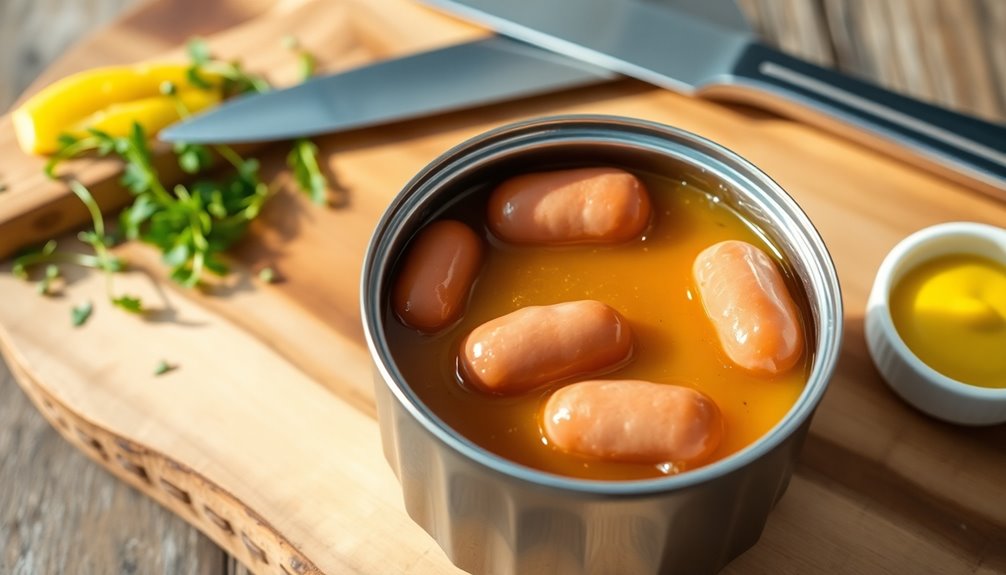
When it comes to preparing Vienna sausages, you'll find that they're incredibly versatile and easy to work with. Since these sausages are pre-cooked, all you need to do is heat them up, maintaining their tender texture and flavor.
Here are some cooking methods you can try for quick snacks:
- Sear in a Skillet: A quick sear in a hot skillet enhances both the texture and flavor, making them more appealing.
- Pan-Fry for Crispness: Slicing the sausages lengthwise and pan-frying them creates a unique presentation and adds crispness.
- Add Flavor: Enhance the taste by incorporating herbs, spices, or even a splash of lemon juice during preparation.
These simple techniques not only elevate the taste but also provide a satisfying crunch.
Plus, Vienna sausages can be easily folded into various dishes like pasta, pizza, or casseroles, adding protein and flavor without extensive cooking time.
Versatile Usage Ideas

When you're in a pinch for a quick meal, Vienna sausages can be your go-to ingredient.
You can toss them into casseroles or soups for a hearty boost, or even fry them up for a crispy snack.
Plus, they make for creative additions in breakfast dishes or fun mini sandwiches that everyone will love.
Quick Meal Additions
If you're looking for quick meal additions that pack a flavorful punch, Vienna sausages are a fantastic option. With their long shelf life, you can keep them on hand for those busy days when you need a meal in a hurry.
These versatile ingredients can be consumed within minutes, enhancing your dishes with minimal effort.
Here are a few creative ways to incorporate Vienna sausages into your meals:
- Soups and Stews: Add them to your favorite recipes for a protein boost and a savory flavor.
- Breakfast Casseroles and Omelets: Mix them in with eggs and vegetables for a hearty morning meal.
- Mini Sandwiches or Sliders: Perfect for parties, these bite-sized treats are always a hit.
Grilling or sautéing Vienna sausages gives them a crispy exterior, making them an excellent snack or appetizer.
You can even use them as a topping for pizzas, adding protein and a unique taste that elevates your dish.
With these quick meal additions, you'll always have a delicious option at your fingertips!
Creative Snack Ideas
Vienna sausages offer endless possibilities for creative snacking that can delight your taste buds without much effort. Thanks to their long shelf life, these little delights can be consumed anytime you crave a quick bite or an impressive appetizer.
One fantastic idea is to wrap them in bacon and bake until crispy; this simple step transforms them into a mouthwatering party snack that everyone will love.
If you're looking for a heartier option, slice up some Vienna sausages and toss them into your favorite pasta dish. It'll enhance the flavor and add protein in just minutes!
For gatherings, simmer them in tangy BBQ sauce and serve with toothpicks for a fun, hands-on snacking experience.
Don't forget breakfast! Mixing chopped Vienna sausages into scrambled eggs or omelets gives your morning a savory twist.
For a colorful party platter, skewer the sausages with pickles, olives, and cheese cubes, creating visually appealing and tasty bites.
Additionally, serving Vienna sausages alongside a fermented vegetable plate can provide a nutritious balance and enhance gut health.
With these creative snack ideas, you can enjoy Vienna sausages in various delicious ways, proving that they're more than just a pantry staple.
Safe Consumption Practices
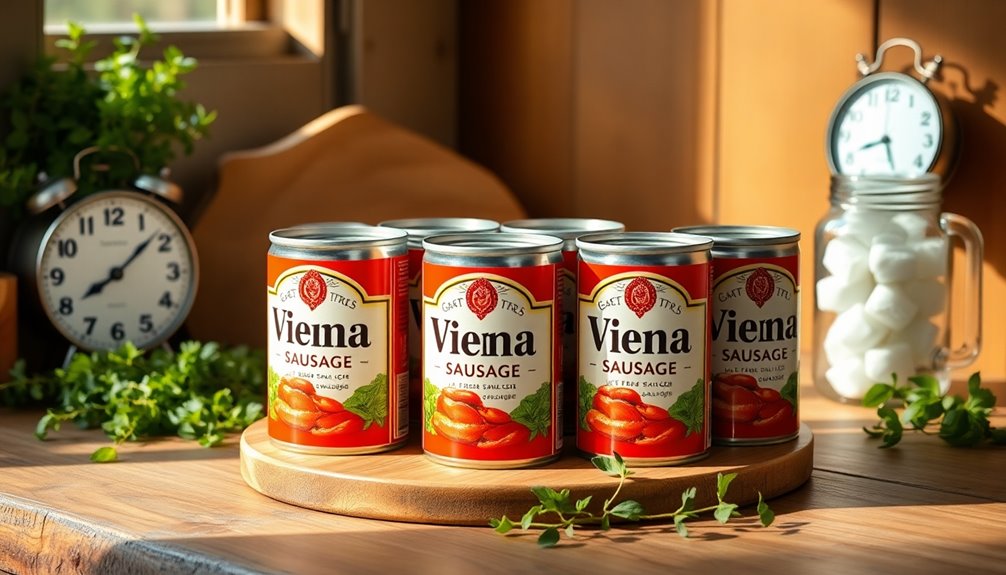
To guarantee your Vienna sausages are safe to eat, it's crucial to follow proper storage and consumption practices. Start by ensuring that any opened cans are transferred to airtight containers and refrigerated. For best freshness and safety, you should consume them within 3 to 4 days.
Always maintain a storage temperature of 40°F (4.4°C) or lower to prevent spoilage and bacterial growth.
Here are some important safe consumption practices to keep in mind:
- Check the expiration date: Always verify that your sausages are still within the recommended timeframe before eating.
- Discard any leftovers: If sausages have been left out at room temperature for more than two hours, they should be discarded to avoid potential foodborne illnesses.
- Inspect for spoilage: Look for signs like off odors, discoloration, or a slimy texture—if you notice any of these, don't hesitate to discard them immediately.
Global Varieties and Adaptations
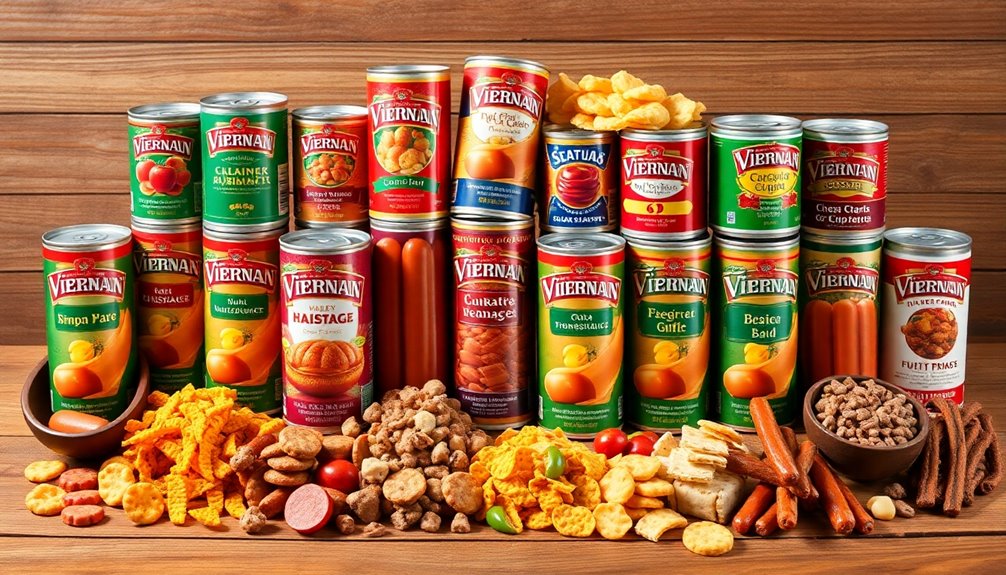
Sausages around the world showcase a delightful variety of flavors and ingredients, with many countries putting their unique spin on the classic Vienna sausage. You'll find global varieties that reflect the culinary traditions of different cultures.
For instance, in Germany, the "Wiener Wurst" is a beloved variation, typically served with sauerkraut and mustard, celebrating the country's rich sausage-making history.
In Spain, "salchichas" incorporate spices like paprika, which sets them apart from traditional Vienna sausages. Meanwhile, Italian "salsiccia" often features herbs like fennel, making it a popular choice for pasta dishes or served alongside bread and cheese.
These adaptations highlight the versatility of sausages while maintaining a connection to the original Vienna concept.
Moreover, you can explore alternative protein sources, like turkey or chicken sausages, that cater to diverse dietary preferences. Indoor air quality can significantly affect the enjoyment of meals, making air purifiers beneficial for creating a pleasant dining environment.
Regardless of the style, it's crucial to remember that while these sausages boast a long shelf life, they should be consumed before their expiration dates to guarantee quality and safety.
Enjoying these global varieties adds a delicious twist to your snacking experience while honoring the rich history of sausages worldwide.
Frequently Asked Questions
Does Vienna Sausage Expire?
Vienna sausages don't expire in the usual way, but they do have a shelf life.
If you keep unopened cans in a cool, dry place, they can last 2-5 years past the Best By date.
Once you open a can, you should eat the sausages within 3-4 days if you refrigerate them.
Always check for spoilage signs like off smells or discoloration before consuming.
If you notice any, it's best to throw them away.
Can a 1 Year Old Eat Vienna Sausages?
Imagine a tiny knight, venturing into the world of food. At one year old, your little knight can indeed enjoy Vienna sausages, but you should proceed with caution.
These soft morsels are easy for them to chew, yet their salty nature means moderation is key. Always slice them into small pieces to prevent choking hazards.
Balance their diet with fresh fruits and veggies, ensuring your young champion grows strong and healthy on this culinary quest.
Is It Okay to Eat Vienna Sausages Out of the Can?
Yes, it's perfectly fine to eat Vienna sausages straight out of the can.
They're pre-cooked and sealed in a sterile environment, so you can enjoy them without heating. Just make certain to check the expiration date and verify the can isn't damaged or bulging.
While it's safe, many people prefer heating them for better flavor.
Just remember, moderation is key since they can be high in sodium. Enjoy your snack!
Does Canned Sausage Go Bad?
Yes, canned sausage can go bad, but it takes time.
If you store it properly in a cool, dark place, it can last 2-5 years past its Best By date.
However, once you open the can, you should eat it within 3-4 days.
Always check for off odors, discoloration, or a slimy texture before consuming.
If the can is bulging, toss it out—it's not safe to eat.
Conclusion
To sum up, Vienna sausages are not just a convenient snack; they can last up to five years when stored properly! Imagine having a tasty treat tucked away for camping trips or emergency kits, ready to satisfy your cravings whenever you need it. By understanding their shelf life and storage methods, you’re set to enjoy these little wonders anytime. So, grab a can and relish the long-lasting delight of Vienna sausages—your taste buds will thank you! Additionally, Vienna sausages pair wonderfully with a variety of accompaniments, making them an excellent choice for quick meals or snacks. Just like you might wonder, “how long does powdered cheese last,” it’s essential to be informed about the shelf life of your favorite pantry staples. Stocking up on both Vienna sausages and powdered cheese ensures that you’re always prepared for spontaneous get-togethers or cozy nights in.










